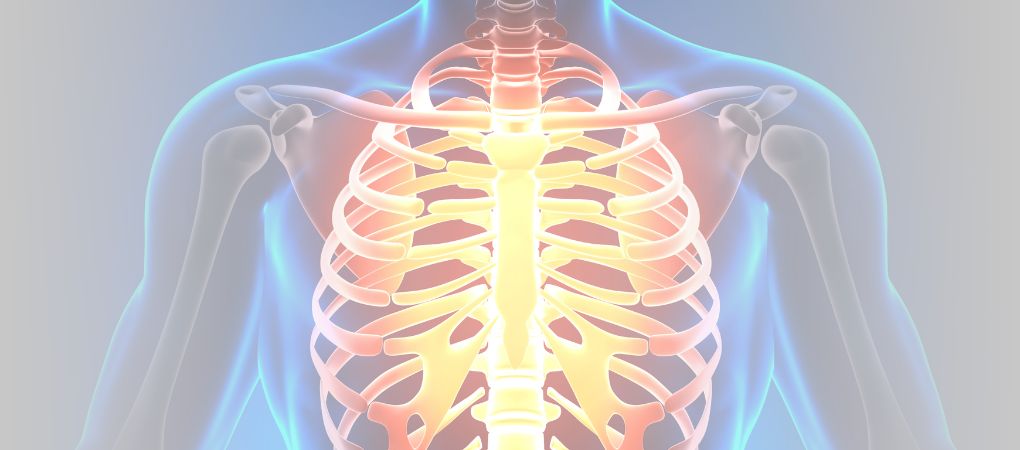Francesca Galiano
|
07/09/2022 - Last update 29/12/2022
Javier Barranco-Trabi, Vittoria Mank, Jefferson Roberts, David P. Newman | Year 2021
Barranco-Trabi – Atypical Costochondritis, Complete Resolution of Symptoms After Rib Manipulation and Soft Tissue Mobilization
Pathology:
Atypical costochondritis
Type of study:
Case report
Date of publication of the study’:
2021/Apr/08

Purpose of the study
- Objective: to report the utility of OMT in treating costal dysfunctions in an atypical costochondritis
- Measured outcomes: report of the symptomes
Participants
- Number: 1
- Description: 37-year-old man with intermittent pain along the right anterolateral rib cage for two years. There had been no trauma.
The pain was sharp and burning, manifesting especially in the morning upon awakening and for 15 minutes afterwards. Moreover, the pain would worsen with palpation on the costochondral cartilage between the sternum and the 8th, 9th and tenth ribs. The pain tends then to manifest while running or when straining the cardiovascular system with an intensity of about 4-6 out of 10 on Visual Analog Scale (VAS).
The man felt very frustrated because of the chronicity of these symptoms persisting in spite of the conservative therapies.
Initially, the pain emerged on the right side, although there was a history of pain in the left side for several months which had eventually resolved.After a detailed medical cardiological, gastroenterological and physiotherapy analysis, the diagnosis was of costochondritis, as a series of tests (gastroenteric, cardiac, radiographic, haematochemical, cutaneous) were negative.
After 2 years of persistent pain, the patient underwent an intercostal nerve block with ropivacaine and dexamethasone injected at the right T8-9 intercostal space. Although the pain went from 7 out of 10 to 0 out of 10 after the intervention, at the three-week follow-up it had reappeared just the same as before the intervention.
At this point, the patient arrived at the present visit to shed some light on the diagnosis and resolve the pain.
At the physical evaluation, the cervical spine was normal and with no dysfunctions, whereas an analysis of the thoracic spine showed a reproduction of the pain through combined extension and rotation to the right. A hypomobility at the level of T9 and T10 vertebrae was detected and a reproduction of his pain in case of anterior pressure. The diaphragmatic evaluation revealed an asymmetry of the motion of the ribs 9 and 10.
On the basis of both the examination and the clinical history, a diagnosis of atypical costochondritis was issued, as the signs and symptoms would indicate a costochondritis, but the duration and involvement of the lower ribs were atypical.
Interventions and evaluations
- Evaluation of pain at each visit
- 3 visits (2 daily and 1 after two weeks)
- OMT focused on the manipulation of ribs 9 and 10
- Assisted tissue mobilization with use of specific instruments (cuppetting) at the level of the ninth and tenth ribs and of the sternum
- Stretching exercises instructed on latissimus dorsi and on the pectoralis major/minor for self management
Results
After the OMT the rib cage motion did not produce any more pain, while, after the first visit (OMT and cupping), the morning pain started to decrease going from 10 to 2.
The pressure on the T9 and T10 vertebrae no longer reproduced pain, while the costal movement during breathing had become symmetrical. Since the rib palpation still reproduced his pain, cupping was performed again and stretching exercises were recommended.
On the third visit, the patient reported pain resolution, both in the morning and during activities such as jogging.
None of the following reproduced the pain: thoracic motion, pressure on the vertebrae and a functional test (abdominal muscles).
Discussion
In the presence of an unusual diagnosis, as the symptomatology is atypical for a costochondritis, though no other examination has detected any alteration linked to other systems, a conservative treatment based on OMT, cupping and exercises (which, however, were not followed with constancy) showed to be able to resolve the pain linked to this condition.
Since the pathogenesis of costochondritis is not well defined, and even less so in this particular case, the mechanisms that allowed the therapeutic program to resolve the pain are unclear.
Possibly, a biomechanical alteration, potentially due to muscular efforts of the surrounding regions, induced an excessive load on the costal cartilage consequently inducing neurogenic inflammation and pain. Acting on interstitial receptors and nociceptors, OMT and cupping may have favored a rebalancing. Furthermore, there could have been some myofascial adhesion in the area.
Given the duration of the symptoms, it should be noted that the patient may not have remembered some important information that might have helped to better frame his condition.
Of course, studies on a wider population are needed in order to generalize the utility of a similar intervention programme.
The review of Osteopedia
By Marco Chiera
Strengths: good description of the tests carried out and of the process of differential diagnosis, also with the support of figures; good description (and tabular representation) of the course of therapy; good discussion of the difficulties of diagnosing costochondritis and understanding the possible therapy rationale; description of an integrated therapeutic program.
Limits: there was no follow-up (the pain could have returned after some time); there are no indication to understand how much OMT actually affected the resolution of the pain; it would have been interesting to describe which conservative therapies the patient followed unsuccessfully.

Are you an osteopath?
Register and enjoy the membership benefits. Create your public profile and publish your studies. It's free!
Register now
School or training institution?
Register and enjoy the membership benefits. Create your public profile and publish your studies. It's free!
Register now
Do you want to become an osteopath? Are you a student?
Register and enjoy the membership benefits. Create your public profile and publish your studies. It's free!
Register now







